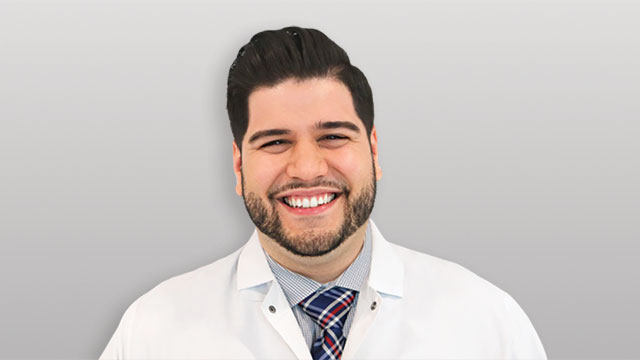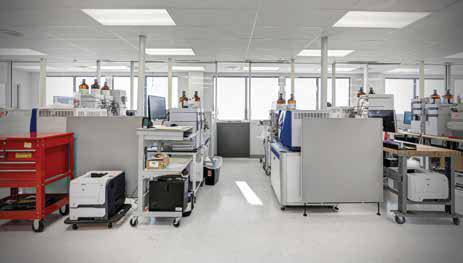
Alejandro Amador, chief operations officer of Ammon Labs, is an ASCP-certified clinical laboratory technologist with experience in chemistry, endocrinology, immunology, microbiology, molecular genetics, and toxicology. He is proficient in liquid chromatography-tandem mass spectrometry (LC-MS-MS) method development, assay validations, and statistical analysis. Additionally, Amador has substantial experience in clinical laboratory management and has been an integral part of Ammon Labs’ substantial growth over the past year. Amador is a graduate of Rutgers University in New Jersey.
Q: What kind of narcotics testing does Ammon Labs most commonly do?
A: We are a full-service lab, and we encompass all major disciplines in a clinical lab. However, our main focus since inception has been toxicology. We run the gamut of all toxicology testing, and we use a two-step testing system— homogenous enzyme amino assays to perform presumptive testing and liquid chromatography-mass spectrometry to perform our confirmations.
Q: What key instruments and techniques do you use for narcotics testing?
A: For our instrumentation on the screens, we run enzyme immunoassays on Olympus AU instrumentation. Screens are prone to both false positives and false negatives. They are very sensitive but not very specific. It is not definitive testing; the keyword is that it is presumptive—it separates all your negatives from your presumptive positives. Ideally, from a presumptive screen, the sample gets sent to a confirmation lab and that is run on LC-MS-MS. We use a dilute-and-shoot method for our methodology. The biggest takeaway from LC-MS is that it might tell you a drug is there, but it cannot tell you how that drug got there.
Q: How many samples do you typically deal with in a month? How many staff members are involved in the narcotics testing side of things?
A: We typically do about 30,000 patients a month, and more than 3 million individual tests. We have about 100 employees working on toxicology, and that includes collection staff, pre-analytical staff in the lab, our analytical staff in the lab, our data reviewers, etc.
Q: What have been the major changes/trends in narcotics testing recently?
A: The biggest trend is the emergence of synthetic compounds, and this provides a significant challenge to laboratory testing. Unfortunately, laboratories are always behind [with] the latest drugs people can purchase. Because we are bound by 1) the DEA and FDA making the new drug a scheduled substance, and then 2) having a vendor that can manufacture the standard, the laboratory is always behind. The other issue with synthetics is that as soon as you develop a test, a chemist can just tweak the molecule and now the test is no longer viable.
Another challenge is obviously dealing with the opioid epidemic. Everyone is always asking for different compounds to be tested, so we’re making specialized panels that are more challenging to develop. The emergence of synthetic opiates poses a significant risk to the patients who are consuming these compounds, as well as our laboratory staff. So we take precautions to protect everyone, because even just a little amount of a synthetic opiate can be lethal.
Q: How have those changes affected Ammon Labs?
A: It has led to a period of continuous innovation because we are constantly trying to make these new compounds, and as soon as a new compound is available, we want to make sure that we’re actually testing it.
 Inside Ammon Labs’ state-of-the-art laboratory in Linden, N.J.We also have a client service branch in our company, so our professionals go out to facilities and ask about new compounds that patients are alerting them to. We’re always keeping our ears to the ground. We try to pull as much information [as possible] from our facilities to get ahead of the trend.
Inside Ammon Labs’ state-of-the-art laboratory in Linden, N.J.We also have a client service branch in our company, so our professionals go out to facilities and ask about new compounds that patients are alerting them to. We’re always keeping our ears to the ground. We try to pull as much information [as possible] from our facilities to get ahead of the trend.
Before, you used to test for your basic illicits—marijuana, PCP, heroin—now you have all these new emerging drugs of abuse such as synthetic compounds, behavioral compounds, and even new illicits like bath salts.
Once we get a standard, we revalidate or reoptimize our current method to include the new compound and figure out how the compound may affect our current method. It is a big process to get going.
Q: What are some of the main challenges you run into when it comes to narcotics testing? How do you handle those challenges?
A: The opioid epidemic has exposed many of our clients, like counselors and clinical staff, to brand new compounds and concepts. There’s a ton of misconception when it comes to drug testing and, more importantly, how to interpret results.
We recognize the importance of education and strive to help our clients understand the significance of drug testing. One of my jobs is to actually visit facilities and provide workshops on the basics of drug testing. We also invite clients to our laboratory to take tours, observe our processes, and ask the staff any questions. The best value that any laboratory in toxicology can offer is an analytical line—essentially, your clients need to be able to call your laboratory and talk to the toxicologist whenever they need help understanding the results.
Lab Management Certificate
The Lab Management certificate is more than training—it’s a professional advantage.
Gain critical skills and IACET-approved CEUs that make a measurable difference.
Q: What advice do you have for lab professionals who are interested in getting into narcotics testing but may not know where to start or if it’s the field for them?
A: I came from the other area of the clinical lab and have been involved in toxicology for six or seven years, and I can say that toxicology has a very steep learning curve. Significant expertise is needed and the laboratory has to commit to a significant investment to get personnel proficient in toxicology. Here at Ammon, we offer an internship program for recent grads or inexperienced candidates. We take them from the beginning of the lab to the end. We feel that with someone coming in with little experience, teaching them the foundational pieces in each area of the lab helps them understand the whole process better. It can take a minimum of six months of training to become specialized in toxicology.
Toxicology is seen as two different areas—the screening side and the confirmatory side. The screening side is similar to what you’d do in chemistry. Confirmations, on the other hand, use LC-MS instruments, which are unlike any other instrument in the lab. They require a lot of troubleshooting, critical thinking, and hands-on effort.
Q: What is Ammon Labs’ plan for the future, in terms of narcotics testing?
A: We’re acquiring new instruments every few months. For example, we recently bought the latest instrument from AB Sciex, the 6500. We want to cater it toward research and development.
We’d also like to partner with universities for research initiatives, because most labs use instrumentation in the 4500 range for nanogram levels. But research settings need to get down to the picogram level. This is important, because as more states legalize marijuana, they are looking for ways to detect secondhand smoke in children and determine the potential effects on development. We want to get more into research and development and provide valuable reporting back to universities and government agencies.
We also have a lot of automation in our lab, which is key to toxicology, but we’re always trying to automate as much of the process as we can. So we’re looking to partner with Tecan to become more automated and reduce human error and improve efficiency. We are also looking to make an investment in screening instrumentations for more throughput and scalable capacity.
And as always, we of course want to be on the forefront of emerging drugs of abuse. We want to continue to develop new methods that our clients ask for in the testing of new drugs.












